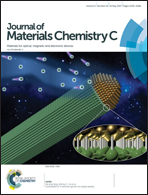Controllable III–V nanowire growth via catalyst epitaxy†
Abstract
Controllable synthesis of III–V compound semiconductor nanowires (NWs) with high crystallinity and uniformity is essential for their large-scale practical use in various technological applications, especially for those which are grown on non-crystalline substrates. In this study, the catalytic effect is investigated thoroughly in the growth of various III–V NWs in solid-source chemical vapor deposition, including Pd, Ag and Ni catalyzed GaAs NWs and Au catalyzed InGaAs and GaSb NWs. It is found that small diameter catalyst seeds lead to faster NW growth with better crystal quality, while large seeds result in slower NW growth with kinked morphology and twinning defects. Importantly, these small catalyst nanoparticles are observed to have higher solubility of the group III precursors due to the Gibbs–Thomson effect, which not only enables effective III precursor diffusion for a faster growth rate, but also yields epitaxial growth of NWs from the catalyst seeds accounting for the low activation energy and better crystallinity. All these results explicitly demonstrate the effectiveness of this catalyst solubility and epitaxy engineering for controlled III–V NW growth and indicate the potency for the reliable production of high-performance NWs for next-generation electronics.

- This article is part of the themed collection: 2017 Journal of Materials Chemistry C HOT Papers


 Please wait while we load your content...
Please wait while we load your content...